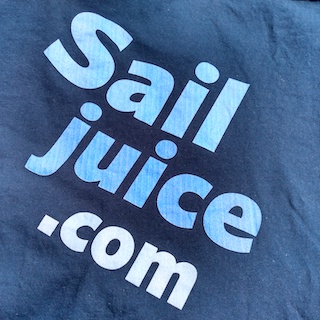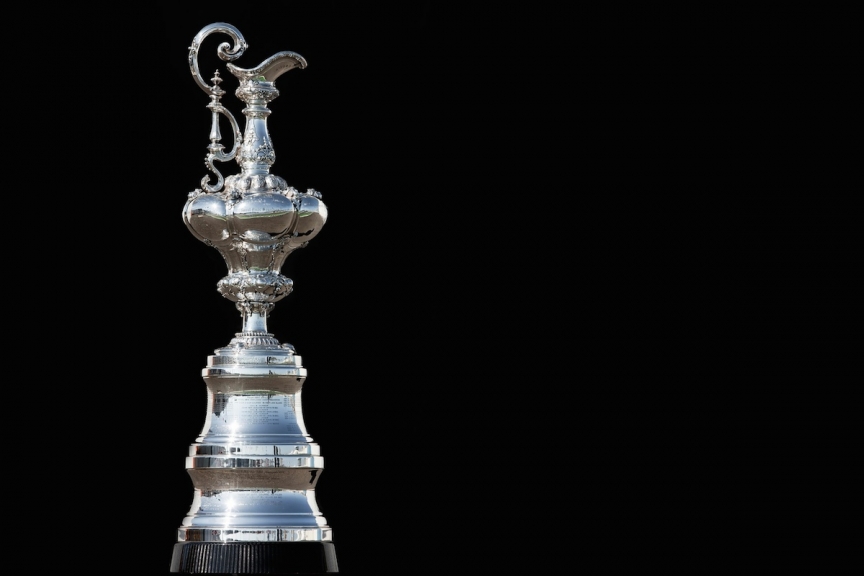Before you got into sailing - if you can remember back that far - what did you think was meant by the term ‘dinghy’? I didn’t take up sailing until I was 13, and so to me a dinghy was a blow-up piece of plastic that you bought from a shop at the seaside and inflated on the beach while wearing your Speedos. Speedos weren’t a joke term back in the day, by the way.
Of course, now I know a dinghy to be a boat that doesn’t have a keel. A keelboat is a boat with a keel, otherwise known as a yacht. The word ‘yacht’ originates from the Dutch word ‘jacht’, meaning ‘hunt’. A yacht was originally defined as a light and nimble sailing vessel used by the Dutch Navy to chase and hunt down pirates and other undesirables on the North Sea. That’s quite a sexy term, but the trouble is, these days a yacht is associated with being posh and elitist. Hence the International Yacht Racing Union changing its name to the International Sailing Federation. If the RYA or a magazine called Yachts & Yachting were to be born today, they probably would be named differently.
But what - if not a yacht - to call a boat that sails? ‘Yacht’ is too posh, ‘keelboat’ sort of works for describing boats with keels, but dinghy sounds a bit too trivial, and is too easily misspelled as ‘dingy’. Not good. The American term of ‘sailboat’ is about as good as I can think of, and I’d like to see it used more widely. But apart from some well-known boating brands that have adopted the term, ‘sailboat’ just hadn’t really caught on over this side of the pond.
‘Asymmetric’ is another term that’s hard to say or spell, as I well know, having written a book on the subject. When I was asked to write a book about boats with asymmetric spinnakers, it was hard to think of any decent alternative. ‘Sailing with odd-shaped spinnakers’, maybe? It would have at least avoided the spelling of ‘asymmetric’, which often ends up with two ’s’ and one ‘m’, and in shortened form is referred to as an ‘assy’. Being a pedant in such matters, I should point out that if you’re going to shorten it, call it an ‘asy’. If in doubt about the spelling of this impossible word, just remember that there is no ‘ass’ in ‘asymmetric’.
Talking of asymmetrics, here’s a story that takes asymmetric sailing to a whole new level. When Oracle Team USA took a 48-hour time-out from the America’s Cup match after a heavy defeat in race 5, the American shore crew worked like crazy to make a number of significant modifications to their AC72 catamaran. Some of the mods were easy to see, if you knew where to look, like the change of foils. But one that didn’t emerge until after the event was that Oracle shifted as much weight from the port hull into the starboard hull. Why? Because they had belatedly worked out that the course was skewed, with the majority of upwind sailing done on starboard tack.
The Kiwis had already worked this out during the Louis Vuitton Cup and had ballasted their boat accordingly, and Oracle realised they needed to do the same. On making the change, not only was the American boat significantly faster on starboard, it wasn’t significantly slower on port. Huh? Go figure, as the Americans might say. In a technical sport like sailing, a gain in one area nearly always results in a loss somewhere else. No such thing as a free lunch, right? Except creating this asymmetry in the Oracle boat seemed to defy the traditional logic.
This reminded me of sailing the International 14 a few years ago with Mike Lennon, when we were keen to experiment with gybing boards which a trio of American boats had used as they went on to dominate the podium of the 2006 World Championship at Long Beach, California. Mike told me about a Scorpion that he had raced some years earlier when the centreboard was unintentionally warped - giving him fantastic height on starboard tack but without a corresponding drop in performance on port. Who wouldn’t take that, when getting off the start line on starboard tack is such a critical part of a fleet race?
Anyway, Mike managed to recreate the incredibly efficient gybing board system in the 14 that Howie Hamlin and Euan McNicol had used to win the 2006 Worlds. It had a system that linked the ‘gybing’ mechanism to the mainsheet strops, so that when you tacked and the new windward strop went tight, it automatically tacked the gybing board too. Very neat, very efficient. But was it effective? We really couldn’t tell very much - if any - performance difference, and concluded that Howie’s World title came down to many factors and very little down to the gybing board. On the other hand in the 505, where Howie has also won the world title, you’re not even in the game if you’re not using a gybing board. In the 14, on the other hand, gybing boards have fallen out of fashion again. Strange how what works for one boat doesn’t work for another. But as to the idea of intended asymmetry, that must be an idea worth further exploration.
Roll Tacks - December 2013
Related Articles

America's Cup - June 2012
 Breaking stuff is going to be inevitable in the next hi-tech America’s Cup, so maybe it’s a good thing that Artemis Racing have been the first to break a wing rig for their AC72 multihull. At least, that’s the positive spin Paul Cayard’s putting on it. But I happen to believe him.
Breaking stuff is going to be inevitable in the next hi-tech America’s Cup, so maybe it’s a good thing that Artemis Racing have been the first to break a wing rig for their AC72 multihull. At least, that’s the positive spin Paul Cayard’s putting on it. But I happen to believe him.
Read More
 Breaking stuff is going to be inevitable in the next hi-tech America’s Cup, so maybe it’s a good thing that Artemis Racing have been the first to break a wing rig for their AC72 multihull. At least, that’s the positive spin Paul Cayard’s putting on it. But I happen to believe him.
Breaking stuff is going to be inevitable in the next hi-tech America’s Cup, so maybe it’s a good thing that Artemis Racing have been the first to break a wing rig for their AC72 multihull. At least, that’s the positive spin Paul Cayard’s putting on it. But I happen to believe him. 
America's Cup - April 2012
 With a home crowd to please, Luna Rossa burst on to the America’s Cup World Series with a performance that delighted their passionate fans and struck fear into the hearts of their competitors. The wild reception in Naples was a reminder that no one can top the Italians in their enthusiasm for sport - even sailing!
With a home crowd to please, Luna Rossa burst on to the America’s Cup World Series with a performance that delighted their passionate fans and struck fear into the hearts of their competitors. The wild reception in Naples was a reminder that no one can top the Italians in their enthusiasm for sport - even sailing!
Read More
 With a home crowd to please, Luna Rossa burst on to the America’s Cup World Series with a performance that delighted their passionate fans and struck fear into the hearts of their competitors. The wild reception in Naples was a reminder that no one can top the Italians in their enthusiasm for sport - even sailing!
With a home crowd to please, Luna Rossa burst on to the America’s Cup World Series with a performance that delighted their passionate fans and struck fear into the hearts of their competitors. The wild reception in Naples was a reminder that no one can top the Italians in their enthusiasm for sport - even sailing! 
America's Cup - August 2012
 Any British sailing fan has known just how good Ben Ainslie is for a long time. Even so, watching him win his fourth gold at London 2012 still took my breath away. Question is, will any of that superhuman success ever give Ben a chance to take a leading man’s role in the America’s Cup?
Any British sailing fan has known just how good Ben Ainslie is for a long time. Even so, watching him win his fourth gold at London 2012 still took my breath away. Question is, will any of that superhuman success ever give Ben a chance to take a leading man’s role in the America’s Cup?
Read More
 Any British sailing fan has known just how good Ben Ainslie is for a long time. Even so, watching him win his fourth gold at London 2012 still took my breath away. Question is, will any of that superhuman success ever give Ben a chance to take a leading man’s role in the America’s Cup?
Any British sailing fan has known just how good Ben Ainslie is for a long time. Even so, watching him win his fourth gold at London 2012 still took my breath away. Question is, will any of that superhuman success ever give Ben a chance to take a leading man’s role in the America’s Cup? 
America's Cup - July 2014
 Australia’s shock withdrawal from the Cup is just the latest example of what makes following the America’s Cup so frustrating. I’m struggling to buy into Russell Coutts’s vision for a more commercial event, but one thing we can at least celebrate is the proliferation of hydrofoiling sailcraft that are now appearing in the wake of last year’s amazing final.
Australia’s shock withdrawal from the Cup is just the latest example of what makes following the America’s Cup so frustrating. I’m struggling to buy into Russell Coutts’s vision for a more commercial event, but one thing we can at least celebrate is the proliferation of hydrofoiling sailcraft that are now appearing in the wake of last year’s amazing final.
Read More
 Australia’s shock withdrawal from the Cup is just the latest example of what makes following the America’s Cup so frustrating. I’m struggling to buy into Russell Coutts’s vision for a more commercial event, but one thing we can at least celebrate is the proliferation of hydrofoiling sailcraft that are now appearing in the wake of last year’s amazing final.
Australia’s shock withdrawal from the Cup is just the latest example of what makes following the America’s Cup so frustrating. I’m struggling to buy into Russell Coutts’s vision for a more commercial event, but one thing we can at least celebrate is the proliferation of hydrofoiling sailcraft that are now appearing in the wake of last year’s amazing final. 
Roll Tacks - June 2014
Finn sailors around the world must have breathed a sigh of relief when Ben Ainslie hung up his hiking pads after squeaking that fourth gold medal at London 2012. When Sir Ben said that he was signing off from his glittering Olympic career to focus on the America’s Cup, there were times when I wondered if he would do a ‘Redgrave’ and make a comeback for Rio 2016. But Ben’s hopes and plans for his own Cup campaign seem to be coming together nicely and so we will see a new face representing Great Britain in the men’s heavyweight singlehander, a class that GBR has dominated since Iain Percy won the first of his gold medals at Sydney 2000.
Read More
